Growing up in a kitchen full of flavors and stories, I was always drawn to dishes that connect cultures and generations. The classic Italian muffuletta sandwich is a perfect example. It’s a delicious symbol of Italian culinary heritage, evolving from Sicilian street food to an American favorite.
Picture a sandwich that brings together New Orleans and Sicily in every bite. The muffuletta is more than a meal; it’s a journey through cultural fusion and creativity. It started in 1906 at Central Grocery Co, telling a story of immigration, adaptation, and flavor.
The muffuletta’s magic lies in its storytelling through taste. From the Sicilian loaf to the olive salad, each part reflects tradition, innovation, and the diverse culinary experiences that shape our food culture.
Key Takeaways
- Discover the rich history behind the muffuletta sandwich
- Learn about its origins in New Orleans and Sicilian roots
- Understand the cultural significance of this iconic sandwich
- Explore the unique combination of ingredients that define the muffuletta
- Appreciate how immigrant cuisine shapes American food traditions
The Origins of Muffuletta: From Sicily to New Orleans
The muffuletta sandwich is a tasty part of New Orleans’ food scene. It comes from the mix of Italian and American flavors. Between the 1800s and 1900s, about 40,000 Sicilians moved to the Big Easy. They brought flavors that are now famous.
The muffuletta’s story starts in the French Quarter. This area was once “Little Italy” and “Little Palermo”. Italian immigrants mixed their traditions with New Orleans, creating a unique food culture that people love.
The Central Grocery Legacy
In 1906, Salvatore Lupo opened Central Grocery and Deli. This was where the muffuletta sandwich was first made. Central Grocery became a key part of muffuletta history, introducing a sandwich that became a big deal.
“A sandwich is not just food, it’s a story of migration, creativity, and cultural connection.” – Local New Orleans Food Historian
Italian Immigration Impact
- Sicilians dominated the local oyster industry
- Introduced traditional food celebrations like St. Joseph’s Day
- Brought culinary traditions that transformed local cuisine
Cultural Significance in New Orleans
The muffuletta is more than a sandwich. It shows the strength and adaptability of culture. From the French Quarter to today’s restaurants, it shows the mix of traditions that make New Orleans’ food special.
Classic Italian Muffuletta Sandwich: Essential Components
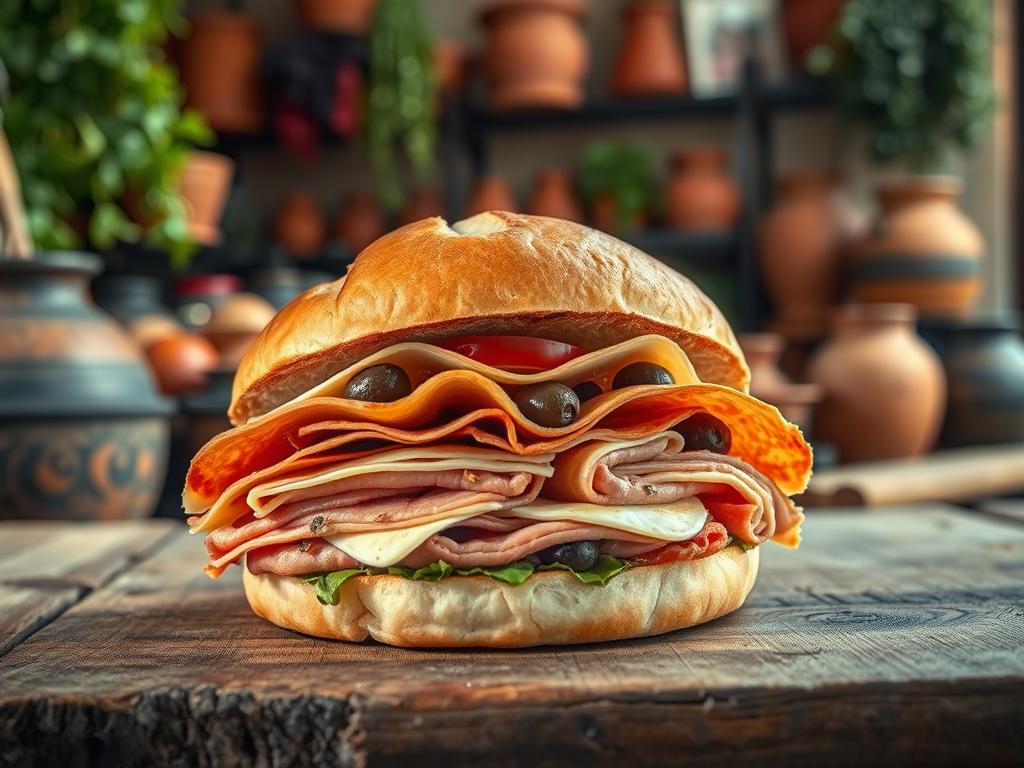
Explore the heart of Italian deli with the famous muffuletta sandwich. It’s a top pick in Italian-American food, blending ingredients for a flavor mix.
The muffuletta’s charm comes from its layers. Let’s look at what makes this sandwich so tasty:
- Meats: A mix of cold cuts
- ½ pound cotta salami
- ½ pound ham
- ½ pound pepperoni
- Cheese: Creamy and rich
- ½ pound provolone
- Olive Salad: The flavor-packed core
- ½ to 1 cup of mixed olives
- Pickled Italian vegetables
- Herbs and olive oil dressing
Every part of the sandwich is important. The meats give a savory base, and the cheese adds creaminess. The olive salad adds a tangy, salty taste.
Pro tip: Quality ingredients are the secret to an authentic muffuletta experience!
This sandwich has 283-550 calories, with lots of protein and fat. It’s more than a meal; it’s a trip through Italian-American food history.
The Perfect Muffuletta Bread Selection
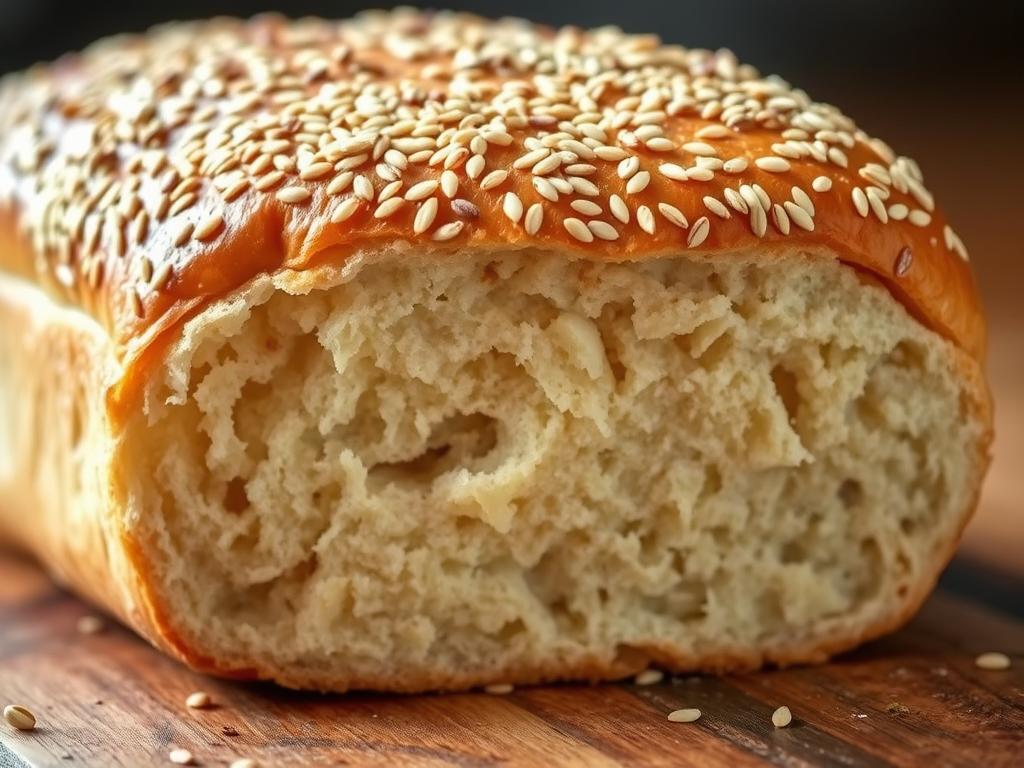
Making a real Italian deli sandwich begins with the right bread. The key to a great muffuletta is its sesame bread. This bread adds a special texture and taste to the sandwich.
The traditional muffuletto bread is round and spongy. It captures the true spirit of the sandwich. This bread type comes from New Orleans and is now linked with the famous muffuletta sandwich.
Traditional Sesame-Seeded Round Bread
Real muffuletta bread has a special feature: lots of sesame seeds. The bread should be:
- Round and about 10 inches wide
- Soft but strong enough to hold meat layers
- Coated thickly with toasted sesame seeds
Alternative Bread Options
Can’t find traditional muffuletto bread? Don’t worry! Here are some great alternatives:
- Ciabatta
- Focaccia
- Large round Italian bread
- Sourdough boule
Proper Bread Preparation Techniques
Getting your bread right is key for a perfect muffuletta. Here are some expert tips:
| Technique | Method |
|---|---|
| Slicing | Cut bread horizontally, making top and bottom halves |
| Toasting | Lightly toast bread to make it crisper |
| Moisture Control | Take out extra bread inside to avoid sogginess |
Pro tip: Let the bread sit at room temperature for the best texture before making your sandwich.
Creating the Signature Olive Salad
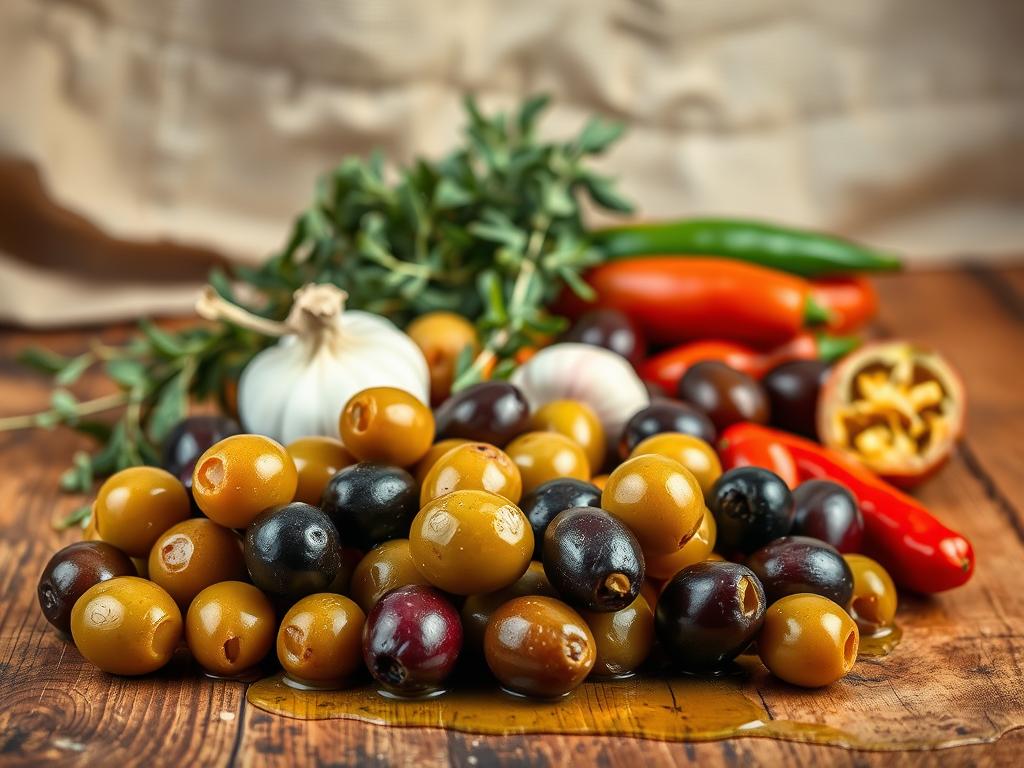
The olive salad is the heart of the muffuletta sandwich. It turns a simple sandwich into a masterpiece with Sicilian flavors. This mix makes the muffuletta stand out, with layers that delight your taste buds.
To make a real olive salad, focus on a few key ingredients:
- Pitted green and black olives
- Roasted red peppers
- Garlic cloves
- Capers
- Fresh herbs
The secret to a great olive salad is in the prep. Roughly chop the ingredients to keep texture. Use a food processor to get a chunky, rustic feel.
Pro tip: Make your olive salad a day ahead. This lets the flavors blend, making it richer. The olive oil and red wine vinegar bring everything together.
Feel free to try new things with your olive salad. While classic recipes are good, your own twist can make it even better!
Mastering the Art of Meat Layering
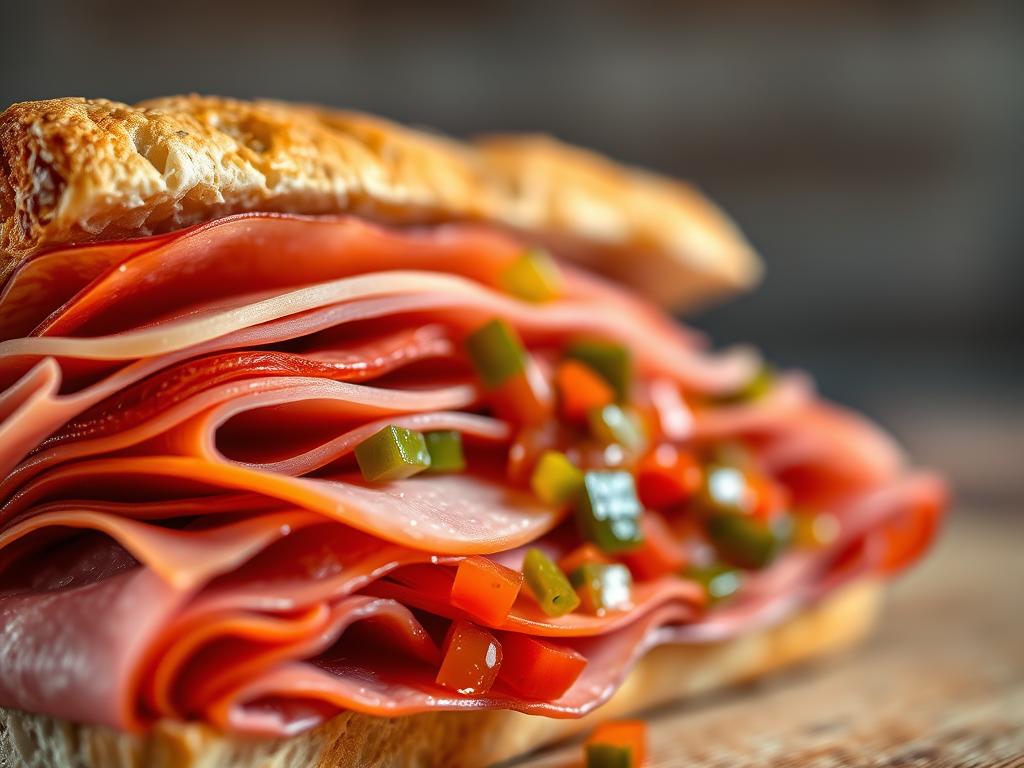
Making the perfect Italian deli sandwich needs precision and care, mainly in meat layering. The muffuletta’s magic comes from its meat arrangement. It turns simple ingredients into a culinary masterpiece.
Our method for a real traditional Italian deli sandwich includes strategic meat placement and careful ingredient mixing. Let’s explore the key techniques to make your muffuletta top-notch.
Genoa Salami Placement
Genoa salami is the base of your meat layers. Use thin, delicate slices for a uniform base. The goal is to cover the bread evenly without too much meat.
- Slice salami extremely thin (approximately 1/16 inch)
- Layer salami with slight overlap for consistent coverage
- Use high-quality, aged Genoa salami for authentic flavor
Mortadella and Capicola Integration
Then, we add mortadella and capicola to add complexity to your cured meats. These traditional Italian deli meats add unique textures and flavors.
| Meat Type | Recommended Quantity | Placement Strategy |
|---|---|---|
| Mortadella | 1/3 pound | Delicate, slightly folded layers |
| Capicola | 1/3 pound | Slightly ruffled for visual appeal |
Proper Portions and Order
Getting the right meat distribution is key. Less is more when making your muffuletta. Thin layers ensure balanced bites and prevent the sandwich from being too heavy.
- Start with Genoa salami as the base layer
- Add mortadella in gentle, overlapping folds
- Place capicola with slight ruffling
- Aim for 3 thin layers of each meat type
By using these techniques, you’ll make a muffuletta that’s authentic and restaurant-quality. It celebrates the rich tradition of cured meats.
Cheese Selection and Placement
Exploring provolone cheese takes us into the heart of Italian culinary traditions. The right cheese makes a muffuletta go from good to great. Provolone, with its sharp and slightly sweet taste, pairs well with salty meats and tangy olive salad.
When picking cheese for your muffuletta, keep these points in mind:
- Flavor intensity of provolone
- Melting characteristics
- Thickness of cheese slices
- Complementary taste with other ingredients
To make your sandwich layers flavorful, place the cheese carefully. Slice the provolone thinly for even melting. Pro tip: Let the cheese warm up to room temperature before you start to make it taste better.
| Cheese Type | Flavor Profile | Recommended Usage |
|---|---|---|
| Provolone Piccante | Sharp, spicy | Primary cheese layer |
| Provolone Dolce | Mild, sweet | Alternative for milder taste |
| Aged Provolone | Intense, complex | For cheese enthusiasts |
The cheese is more than just a topping. It’s a key part that brings all the flavors of your muffuletta together. Try different provolone types to find your favorite!
The Essential Giardiniera Mix
Giardiniera is the vibrant heart of authentic Italian-American culinary traditions. It brings explosive flavor to our beloved muffuletta sandwich. This zesty pickle mix transforms ordinary ingredients into flavorful sandwich layers that sing with Sicilian influences.
Let’s dive into the colorful world of this traditional pickle medley. It adds crunch and tang to our sandwich. Our giardiniera isn’t just a condiment – it’s a culinary storyteller connecting generations of food lovers.
Traditional Vegetable Components
A classic giardiniera typically includes:
- Crisp carrots
- Cauliflower florets
- Bell peppers
- Celery stalks
- Small onions
Pickling Process
The magic happens during pickling. We recommend allowing your giardiniera to develop for approximately 2 weeks. This lets flavors meld and intensify. Our recipe includes 12 distinct ingredients that create a complex, mouth-watering profile.
Flavor Balance
Creating the perfect giardiniera is an art of balancing sour, salty, and spicy elements. Our mix typically contains:
- 3/4 cup pimento-stuffed green olives
- 1/4 cup kalamata olives
- 1/4 cup jarred Italian giardiniera
- 2 large pepperoncini
- 3-4 small pickled onions
- 2 tablespoons capers
Pro tip: Use a food processor to coarsely chop ingredients. This ensures each bite delivers maximum flavor!
Assembly Techniques for the Perfect Stack
Making the perfect Italian deli sandwich is all about precision and care. The art of layering turns a simple muffuletta into a masterpiece. We’ll show you the key steps to ensure every bite is full of authentic flavor.
Here’s how to assemble your classic Italian muffuletta sandwich:
- Start with a large round bread loaf, preferably a traditional sourdough or Italian bread
- Carefully remove about ½ inch of bread from the inside of both halves to reduce excessive breadiness
- Spread a generous layer of olive salad on the bottom bread half
- Begin layering meats strategically:
- First layer: Genoa salami
- Second layer: Capicola
- Third layer: Mortadella
- Add cheese layers between meat selections:
- Provolone
- Swiss cheese
The secret to a great muffuletta is balance. Use at least 3 different meats, with one being spicy. Your goal is to mix flavors in a way that makes your sandwich unforgettable.
Pro tip: Let your sandwich rest for at least 30 minutes before serving. This lets the flavors blend, making your sandwich even more amazing!
Pressing and Resting: The Secret to Muffuletta Success
The muffuletta sandwich is a true gem in traditional Italian deli cuisine. Its success comes from pressing and resting, not just the ingredients.
Pressing makes your sandwich amazing. Use about 10 pounds to press it down. This blends the flavors and layers of meats and cheeses together.
- Total pressing weight: 10 pounds
- Ideal resting time: 1-2 hours
- Recommended temperature: Room temperature
The resting time is key in Italian cooking. It lets the olive salad’s oil soak into the bread and meats. This creates a perfect flavor mix. Let it rest for at least an hour for the best taste.
| Resting Stage | Duration | Flavor Impact |
|---|---|---|
| Initial Compression | 30 minutes | Initial flavor melding |
| Full Resting Period | 1-2 hours | Maximum flavor development |
Pro tip: Even 30 minutes of resting helps. The flavors will keep improving, making your sandwich a true Italian delight.
Serving and Storage Tips
After making your classic Italian muffuletta sandwich, it’s important to know how to serve and store it. We’ll show you the best ways to keep the flavors of this New Orleans favorite just right.
Precision Cutting Techniques
The secret to a great presentation is in how you cut your sandwich. Here are some expert tips:
- Use a sharp serrated knife for clean cuts
- Cut the sandwich into quarters or eighths
- Make sure each slice has all the tasty layers
- Wipe the knife between cuts for clean edges
Temperature Recommendations
The right temperature is key to enjoying your muffuletta. Here’s what we suggest:
- Cold serving: Traditional New Orleans style, perfect for picnics
- Room temperature: Best for letting flavors come together
- Warm serving: Gently heat to 350°F for 20-30 minutes
Storage Guidelines
Here’s how to keep your muffuletta fresh:
- Refrigerate within 2 hours of making it
- Store in an airtight container
- Keeps fresh for up to 1 week in the fridge
- Can be frozen for up to 3 months (without olive salad)
Pro tip: Always remove olive salad before freezing to keep the texture and flavor best!
By using these serving and storage tips, your classic Italian muffuletta sandwich will stay delicious from start to finish.
Conclusion
Our journey into the classic Italian muffuletta sandwich shows more than a recipe. It’s a celebration of Italian-American traditions that have shaped New Orleans cuisine. This sandwich is a delicious mix of cultures, loved by food enthusiasts everywhere.
The muffuletta’s magic comes from its perfect mix of flavors and textures. It has layers of meats, cheeses, and olive salad. Each bite tells a story of immigration, creativity, and innovation. It connects us to Sicilian immigrants who changed American food forever.
We encourage you to try making this iconic sandwich. It’s perfect for home cooks or food lovers interested in cultural cuisine. Cooking is about more than recipes. It’s about the stories and traditions behind each bite.
When you make your own muffuletta, you join a culinary tradition that connects continents and generations. So, get your ingredients ready, be your own chef, and make a meal that honors Italian-American food culture.
🔥🥩 Bold, Hearty & Packed with Flavor – Try This Beef Brisket Chili! 🌶️🍲
Looking for the ultimate comfort food? This Beef Brisket Chili is slow-cooked to perfection, delivering tender, smoky brisket in a rich, spicy sauce. Perfect for game nights, chilly evenings, or whenever you need a satisfying, flavor-packed meal!
✅ Loaded with savory, smoky goodness
✅ Perfect for meal prep & leftovers
✅ A guaranteed crowd-pleaser!🥄 Warm up with a bowl of this incredible chili! 👉 Get the full recipe now! #BeefBrisketChili #ComfortFood #EasyDinner
https://besteverecipes.com/beef-brisket-chili-recipe/

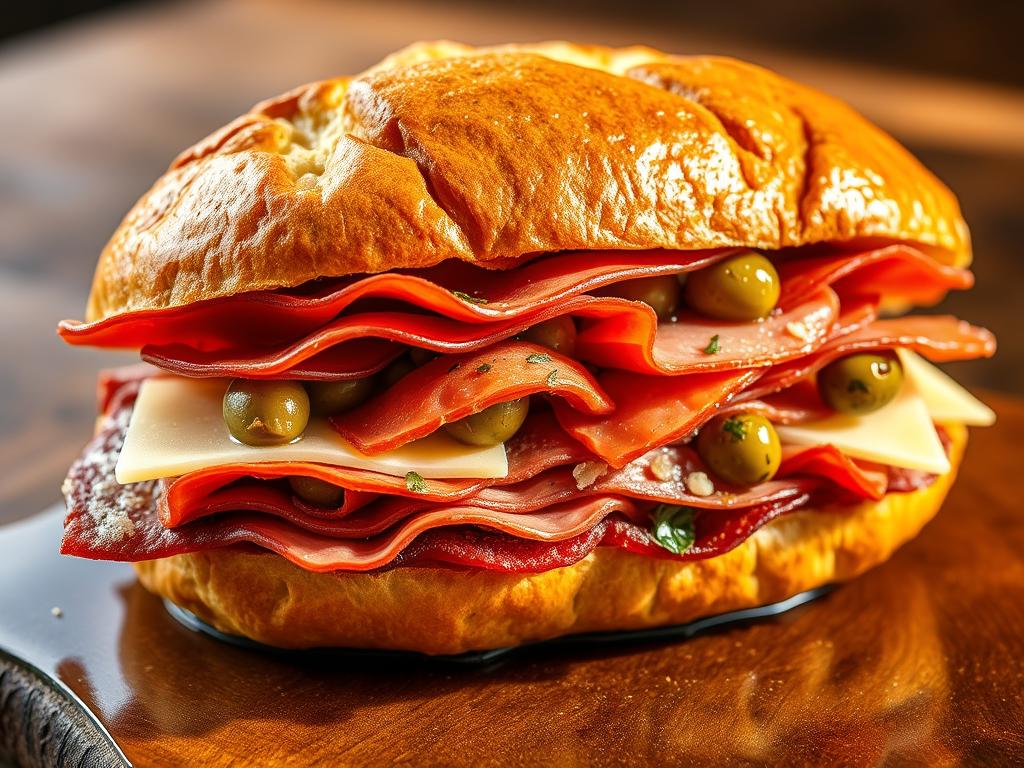
1 thought on “Classic Italian Muffuletta Sandwich: A Must-Try New Orleans Icon”
Comments are closed.